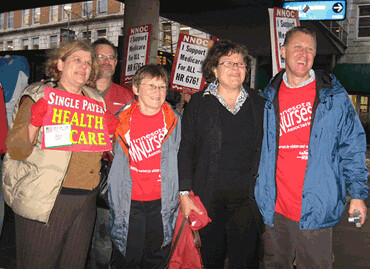 As David Dayen pointed out recently, there is one big name missing from the list of supporters of the Employee Free Choice Act – Senator Dianne Feinstein.
As David Dayen pointed out recently, there is one big name missing from the list of supporters of the Employee Free Choice Act – Senator Dianne Feinstein.
The entire California Democratic Congressional Delegation, including Senator Barbara Boxer, has indicated their support for the bill. And Senator Feinstein co-sponsored and voted for the Employee Free Choice Act in 2007.
Now her support is needed more than ever before. Today Senator Arlen Specter (R-PA) went out of his way to announce his opposition to the Employee Free Choice Act. For many supporters of workers’ right to organize, especially supporters of this bill which will help restore the balance in workers’ decision to join a union away from the union-busting industry that helps employers break unions and keep down wages, Specter’s decision is disappointing. It does mean that it will be more difficult to secure passage of the bill in the Senate.
And that’s precisely why we must insist that Senator Feinstein express her support for the Employee Free Choice Act. To help accomplish that the Courage Campaign is asking its members to sign our petition to Senator Feinstein so that she will know Californians support the Employee Free Choice Act – and that she should as well.
Over the flip is the text of the email we sent to our members.
Dear Robert,
Why is Senator Dianne Feinstein the only Democratic congressional member from California who has not endorsed the Employee Free Choice Act?
The Employee Free Choice Act is an essential piece of our national economic recovery program. It allows workers to organize a union more easily and free from employer interference, giving them the power to more successfully negotiate with large corporations to protect the middle class during this severe recession.
This is one of the most important pieces of legislation this year. President Barack Obama supports it, as do most Democrats, including Senator Barbara Boxer. A Gallup Poll last week found that a clear majority of Americans support the Employee Free Choice Act.
Senator Feinstein, however, has refused to take a position on the bill — even though she co-sponsored it and voted for it in 2007.
With strident Republican opposition, we need every Democratic Senator to support the Employee Free Choice Act.
It’s time we asked Senator Feinstein “which side are you on?” Please sign on to the Courage Campaign’s letter demanding that Senator Feinstein endorse and co-sponsor the Employee Free Choice Act as soon as possible:
http://www.couragecampaign.org…
Large corporations are now funding a massive campaign to mislead the American people about the Employee Free Choice Act and are using Fox News to spew their lies. They falsely claim it would eliminate the secret ballot for workers to authorize union representation.
Even the conservative Wall Street Journal editorial page pointed out that was untrue — the bill merely gives the option for workers to form a union if a majority of them sign cards indicating their support for unionization.
The Employee Free Choice Act will help workers level the playing field with the wealthy and powerful — that’s why a majority of Americans supports its passage. What could possibly prevent Senator Feinstein from endorsing such a progressive bill today — especially when she supported it just two years ago?
Does Senator Feinstein support workers or the large corporations that want to exploit them?
Senator Feinstein needs to hear from you right now. Sign on to our letter to the Senator and tell her that she must side with President Obama and American workers, not Republicans and corporations:
http://www.couragecampaign.org…
Together, we will provide economic recovery to all American workers — and unite Democrats behind one of the most important progressive goals of the year.
Rick Jacobs
Chair, Courage Campaign



 In 2007, right-wing political operatives tried to place a measure on the June 2008 ballot that – if successful – would have awarded California’s electoral votes by Congressional District. Democrats and progressives strongly opposed it, because
In 2007, right-wing political operatives tried to place a measure on the June 2008 ballot that – if successful – would have awarded California’s electoral votes by Congressional District. Democrats and progressives strongly opposed it, because